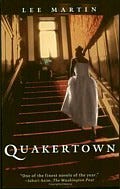In 1921, a thriving Black community called Quakertown formed part of Denton, Texas. Based on actual events, Quakertown is the story of a gifted gardener co-opted into a scheme to relocate his community away from the center of town to make way for a park, and of his light-skinned daughter's love for two men, one the crippled son of a prominent White banker, the other a proud Black World War I veteran.
All of the major characters are complex, flawed individuals portrayed with understanding and sympathy. Mr. Little Washington Jones is justifiably proud of his garden with its lush lawn, catalpa trees, tea roses, and the white lilac bush "he had found ... growing wild along Pecan Creek, showy and magnificent among the scrub of mesquite and bramble." His love for his garden is also the weakness that tempts him to betray his community.
His daughter Camellia's compassionate heart tempts her into loving Kizer, a White boy, even after she grows old enough to know how dangerous it can be to cross the color line. "If she could only touch him the right way, rub her hand over his lame leg, she might heal him."
Kizer's courage awes Camellia when as a boy he allows the doctors to "bust up" his bones in an effort to lengthen his too-short leg. But courage becomes his weakness when, as a young man, he dares to meet her in the college auditorium's darkened balcony. "She felt the tip of his finger touch hers, such a light, quick touch, she could almost believe it hadn't happened."
Another young man's more assertive courage, which makes Camellia tremble with admiration, tempts him to go too far when he is refused access to a "Whites Only" dressing room.
The efforts to live as full human beings draw them ever closer to both calamity and salvation in this unpretentious, graceful and inspiring novel. (2001, 304 pages)




